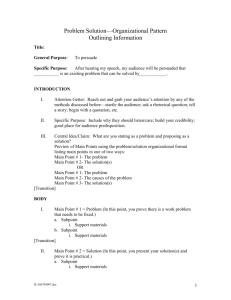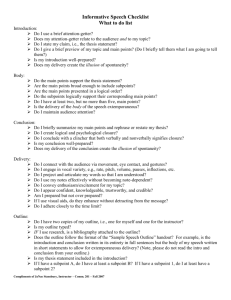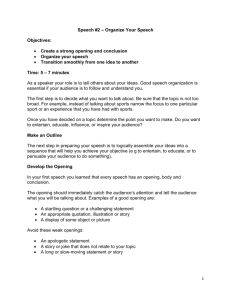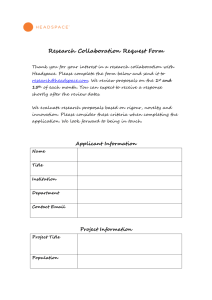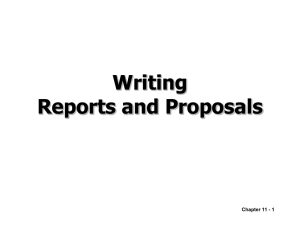Planning Business Messages
advertisement
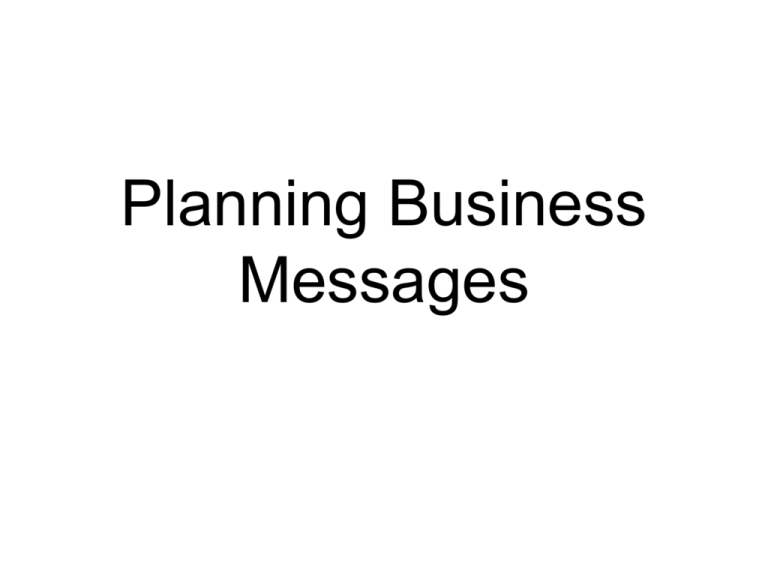
Planning Business Messages Effective Business Messages • Purposeful • Audience-centered • Concise Three-Step Writing Process • Planning • Writing • Completing Analyze Your Purpose • General • Specific – Inform – Realism – Persuade – Timing – Collaborate – Delivery – Acceptability Develop an Audience Profile • Identify primary audience • Determine size • Determine composition • Gauge level of understanding • Project expectations and preferences • Estimate probable reaction Gather Information • Formal sources • Opinions of others • Interviews • Company files • Employees or customers • Audience input Provide Information • Accurate • Complete • Ethical • Pertinent Business Communication Channels and Media • Oral channel • Written channel Selecting the Best Channel and Medium • Style and tone • Feedback • Time • Cost • Audience Relating to the Audience • Use the “you” attitude • Emphasize the positive • Establish credibility • Be polite • Use bias-free language • Project company’s image The “You” Attitude Instead of This Use This To help us process this order, So that your order can be filled we must ask for another copy of promptly, please send another the requisition. copy of the requisition. Instead of This Use This You should never use that type That type of paper doesn’t work of paper in the copy machine. very well in the copy machine. Emphasize the Positive Instead of This Use This It is impossible to repair your Your vacuum cleaner will be vacuum cleaner today. ready by Tuesday. Instead of This Use This •Cheap merchandise •Bargain prices •Toilet paper •Bathroom tissue •Elderly person •Senior citizen Establish Credibility • Show understanding • Explain credentials • Avoid exaggerating • Believe in yourself Be Polite Instead of This Use This You really fouled things up with Let’s review what went wrong that last computer run. so that the next computer run goes smoothly. Instead of This Use This You’ve been sitting on our order We are eager to receive our for two weeks. We need it now! order. When can we expect delivery? Bias-Free Language • Gender • Race or ethnicity • Age • Disability The Company’s Image • Be a spokesperson • Convey the right impression • Minimize your own views • Maximize company interests Writing Business Messages Three-Step Writing Process • Planning • Writing • Completing Organizing the Message • Writer benefits – Save time – Facilitate feedback – Manage the project • Audience benefits – Promote understanding – Boost acceptance – Save time Defining the Main Idea • General purpose • Specific purpose • Basic topic • Main idea Limiting the Scope • Main idea – Space – Time – Length – Detail – Major points – Evidence Outlining Your Points • Use numbers • Indent points to show status • Divide topics into at least two parts • Use one category per subdivision • Make each group separate and distinct Common Outline Form Alphanumeric I. First Major Part Decimal 1.0 First Major Part A. First subpoint 1.1 First subpoint B. Second subpoint 1.2 Second subpoint C. II. 1. Evidence 1.2.1 Evidence 2. Evidence 1.2.2 Evidence Third subpoint Second Major Point 1.2.3 Third subpoint 2.0 Second Major Point A. First subpoint 2.1 First subpoint B. Second subpoint 2.2 Second subpoint Sequencing the Message • Direct approach – Deductive • Indirect approach – Inductive Composing Business Messages • Controlling style and tone • Writing effective sentences • Writing coherent paragraphs Control Style and Tone • Avoid obsolete language • Avoid intimacy • Avoid humor • Avoid preaching or bragging • Write in plain English Balance Your Writing Style • Abstract words – Intellectual – Academic – Philosophical – Conceptual • Concrete words – – – – Direct Material Exact Tangible Finding Words that Communicate • Choose strong words • Prefer familiar words • Avoid clichés • Minimize jargon Writing Effective Sentences • Types of sentences – Simple – Compound – Complex – Compound-complex Effective Sentence Style • Stress key relationships • Emphasize important ideas The Active Voice Avoid Passive Voice in General •There are problems with this contract. •It is necessary that the report be finished by next week. Use Active Voice in General •This contract has problems. •The report must be finished by next week. The Passive Voice Sometimes Avoid Active Voice •You lost the shipment. •We have established criteria to evaluate capital expenditures. Sometimes Use Passive Voice •The shipment was lost. •Criteria have been established to evaluate capital expenditures. Coherent Paragraphs • Length and form • Development • Unity and coherence Paragraph Development • Illustration • Comparison and contrast • Cause and effect • Classification • Problem and solution Frequently Used Transitions Additional Detail •Moreover, furthermore, in addition Causal Relationship •Therefore, because, since, thus Comparison •Similarly, likewise, still, in comparison Contrast •Whereas, conversely, yet, however Illustration •For example, in particular, in this case Time Sequence •Formerly, after, meanwhile, sometimes Summary •In brief, in short, to sum up Completing Business Messages Three-Step Writing Process • Planning • Writing • Completing Revise for Effectiveness • Content • Organization • Style • Tone Revise for Clarity • Break up overly long sentences • Rewrite hedging sentences • Impose parallelism • Correct dangling modifiers Revise for Clarity • Reword long noun sequences • Replace camouflaged verbs • Clarify sentence structure • Clarify awkward references • Moderate your enthusiasm Revise for Conciseness • Delete unnecessary words and phrases • Shorten long words and phrases • Eliminate redundancies • Recast “It is/There are” starters Produce Your Message • Document design • Graphics and hypertext Design Elements • White space • Margins • Justification • Typefaces • Type styles Effective Document Design • Consistency • Balance • Detail • Restraint Improve Your Documents with Computers • Revision tools • Spell checker • Thesaurus • Grammar checker Graphics, Sound and Hypertext • Presentation software – Overhead transparencies – Computerized slide shows • Graphics software – Simple diagrams and charts – Complex graphical designs Proofread the Message • Overall format • Grammar, usage, and punctuation • Spelling errors and typos • Missing material • Design errors Proofreading Pointers • Make multiple passes • Use perceptual tricks • Obtain impartial reviews • Distance yourself • Be vigilant • Stay focused • Practice caution Working with Letters, Memos, and E-Mail Messages Sending Letters, Memos, and E-Mail • Audience • Format • Readability • Strategy Communication • Internal – Understand the organization’s mission – Identify potential problems – React to changes • External – Cultivate an impression – Respond to crises – Gather information Format Differences • Audience – Internal – External • Types of messages – Letters – Memos – E-mail Format for Business Letters • • • • • • • Letterhead stationery Date Inside address Salutation The message Complimentary close Signature block Format for Memos • Memo title • Headings • The message Format for E-Mail • • • • • Headings Salutation The message Complimentary close Signature block Improving Readability in Short Messages • Vary length of sentences • Shorten paragraphs Using Lists and Bullets • Sequence your ideas • Boost visual impact • Highlight key points • Simplify complex subjects • Help readers skim the text Headings and Sub-Headings • Types of headings – Informative – Descriptive • Functions of headings – Organization – Attention – Connection E-Mail Readability • Subject lines • Easy-to-follow messages • Personalized messages E-Mail Etiquette • Practice courtesy • Send brief e-mail • Compose carefully Practice Courtesy • • • • Compose offline Know the audience Clarify time zones Avoid flaming • • • • Limit messages Respect cultures Observe schedules Prioritize e-mail Send Brief E-Mail • Narrow scope • Short messages • Concise statements Compose Carefully • • • • Reply with care Understand “cc” and “bcc” fields Slow down Reread and edit Categories of Messages • Routine, good-news, goodwill • Bad-news • Persuasive Writing Routine, GoodNews, and Goodwill Messages The Three-Step Process • Planning • Writing • Completing Routine Requests • Make your request • Justify your request • Conclude your message State Your Request • Use a courteous tone • Be specific and precise • Assume reader compliance • Avoid personal introductions • Use questions and polite requests Justify Your Request • Explain the request • Offer reader benefits • Ask questions Conclude Your Message • Request specific action • Provide contact information • Promote goodwill Types of Routine Requests • Business orders • Information and action • Claims and adjustments • References and recommendations Business Orders • State your request • Clarify the order • Provide shipping information Action and Information • State why you are writing • Explain the request • Ask for specific action Claims and Adjustments • State the problem • Support your assertions • Propose a solution References and Recommendations • State the request • Provide a résumé • Say “Thank You” Routine Replies and Positive Messages • Impart information • Answer questions • Provide details • Promote goodwill The Direct Approach • Main idea • Relevant details • Cordial close Types of Routine Replies and Positive Messages • Requests for action and information • Claims and requests for adjustments • Recommendations and references • Messages that promote goodwill Action and Information • Be prompt • Be gracious • Be thorough Claims and Requests for Adjustment • Who is at fault? – The company – The customer – A third party References and Recommendations • Be forthright • Be specific • Stick to the facts • Avoid value judgments Goodwill Messages • Congratulations • Appreciation • Condolences Writing Bad-News Messages The Three-Step Process • Planning • Writing • Completing Strategies for Bad-news Messages • Convey the message • Gain acceptance • Maintain goodwill • Promote a good corporate image • Minimize future correspondence Audience-Centered Tone • The “You” attitude • Positive wording • Respectful language The Direct Approach • State the bad news • Give reasons • End with a positive close The Indirect Approach • Begin with a buffer • Follow with reasons • State the bad news • End with a positive close Begin With a Buffer • Sincere • Respectful • Relevant • Succinct • Not misleading • Assertive • Neutral • Brief Provide Reasons That Support the Refusal • Cover positive points • Provide relevant details • Highlight benefits • Minimize company policy • Avoid apologizing State the Message • De-emphasize the bad news • Use a conditional statement • Focus on the positive • Avoid blunt language Close With Confidence • Maintain a positive tone • Limit future correspondence • Be optimistic about the future • Remain confident and sincere Writing Bad-News Messages • Routine requests • Organizational news • Employment information Routine Workplace Requests • Business information • Invitations and favors The Status of Orders • Ship either part or none of the order – Work toward an eventual sale – Communicate clearly – Be confident and optimistic Claims and Adjustments • Things to employ • Things to avoid – Courtesy and tact – Accepting blame – Indirect approach – Accusations – Understanding – Negative language – Alternatives – Defamation Organizational News • Bad news about products • Bad news about company operations Letters of Recommendation • Requested by businesses – Be direct – State facts • Requested by individuals – Practice diplomacy – Consider feelings Employment Applications • Use the direct approach • State reasons clearly • Suggest alternatives Performance Reviews • Review the job requirements • Provide feedback • Develop a plan of action Negative Performance Reviews • Confront the problem • Plan the message • Maintain privacy • Focus on the problem • Obtain commitment Writing Persuasive Messages Three-Step Persuasion Process • Planning • Writing • Completing Analyze Your Purpose • Clear • Necessary • Appropriate Gauge the Audience • Demographics • Psychographics – Gender – Personality – Income – Attitudes – Education – Lifestyle Considering Cultural Differences • Individual differences • Organizational differences Establishing Credibility • Facts • Objectivity • Sources • Sincerity • Expertise • Trust • Common ground • Good intentions • Enthusiasm Setting Ethical Standards • Provide information • Boost understanding • Promote free choice • Avoid manipulation Writing Persuasive Messages • Approach – Direct (deductive) – Indirect (inductive) • Important Elements – Define the main idea – Limit the scope – Group major point Completing the Message • Evaluate the content • Revise for clarity and conciseness • Proofread the message • Evaluate design and delivery Logic and Emotions • Promote action • Understand expectations • Overcome resistance • Sell your point of view The AIDA Plan • Attention • Interest • Desire • Action Persuasive Requests • Action requests • Claims and adjustments Requests for Action • Gain attention • Use facts, figures, and benefits • Request some specific action Claims and Adjustments • State the problem • Review the facts • Motivate the reader • Make your request Sales and Fundraising Messages • For-profit organizations • Not-for-profit organizations Sales Message Strategies • Emphasizing selling points • Stressing benefits • Remembering legal issues Sales Message Strategies • Using action terms • Talking about price • Supporting your claims Getting Attention • News items • Product samples • Features and benefits • Emotions or values • Numbers or questions • Shared traits • Stories and illustrations • Challenges • Solutions The Central Selling Point • Study the competition • Know the product • Analyze the audience Increasing Desire • Stress the main benefit • Refer to other benefits • Provide essential details Motivating Action • Explain the next step • Create urgency • Use a post script • Apply good judgment Writing Fundraising Messages • Analyze the audience • Study the competition • Clarify benefits • Keep the message personal Strengthening Fundraising Messages • Interest readers • Use plain language • Offer an opportunity • Make it hard to refuse • Clarify your needs • Write concisely • Include reply forms • Use versatile enclosures Understanding and Planning Business Reports and Proposals Reports and Proposals • Guide decisions • Comply with government regulations • Gain acceptance of others • Monitor and control operations • Implement policies and procedures • Document results Classifying Reports • Source • Frequency • Audience • Length • Intent Informational Reports • Monitor and control operations • State policies and procedures • Comply with government regulations • Document progress on projects Analytical Reports • Problem-solving reports • Business proposals Solving Problems • Troubleshooting reports • Feasibility reports • Justification reports Writing Proposals • Internal • External • Solicited • Unsolicited Three-Step Writing Process • Planning • Writing • Completing Planning Reports • Analysis • Investigation • Adaptation Analyzing the Situation • Informational reports • Analytical reports Defining the Problem • What needs to be determined? • Why is this issue important? • Who is involved in the situation? • Where is the trouble located? • How did the situation originate? • When did it start? Writing a Purpose Statement • Analytical • Informational – Analyze – To summarize – Evaluate – To explain – Recommend – To submit Drafting a Preliminary Outline Descriptive (Topical) Informative (Talking) I. Industry Characteristics I. What is the nature of the industry? A. Annual Sales A. What are the annual sales? B. Profitability B. Is the industry profitable? C. Growth Rate C. What is the growth pattern? 1. Sales 1. Sales growth? 2. Profit 2. Profit growth? Preparing the Work Plan • • • • • • • State the problem State the purpose and scope Discuss tasks to be accomplished Review final products or outcomes Review schedules and requirements Set follow-up plans Compose a working outline Business Information on the Internet • Internet public library • Company Websites • News release sites Searching Databases • Use multiple search engines • Replace concepts with key words • Use variations of search terms • Specify phrases and key words • Refine searches as needed Sources of Primary Information • Documents • Observations • Experiments Effective Surveys • Provide clear instructions • Use short questionnaires • Seek easy-to-analyze questions • Avoid leading questions • Ask one thing at a time • Pretest all questionnaires Effective Interviews • Plan the interview • Prepare questions • Prioritize questions • Don’t ask too many questions • Edit the questions • Process information Documenting Sources • Copyrighted material • General knowledge Interpret Your Findings • Conclusions and recommendations – Assumptions – Facts – Judgment – Values Writing and Completing Business Reports and Proposals Three-Step Writing Process • Planning • Writing • Completing Organizing Reports and Proposals • Format • Length • Order • Structure Selecting Format and Length • Preprinted form • Letter • Memo • Manuscript Choosing an Approach • Direct approach – Receptive audience – Open-minded audience • Indirect approach – Skeptical audience – Hostile audience Structuring Informational Reports • Importance • Sequence • Chronology • Spatial orientation • Geography • Category Structuring Analytical Reports • Audience members – Receptive – Skeptical • Focus – Conclusions – Recommendations – Logical arguments Structuring Proposals • Solicited (direct approach) – Receptive audience – Recognized problem – Identified solution • Unsolicited (indirect approach) – Skeptical audience – Unrecognized problem – Proposed solution Selecting Visual Aids • Tables • Pie charts • Line or bar charts • Line or dot charts • Pie or area charts • Maps • Bar charts • Flow charts The Parts of a Table Stub head Subhead Subhead Single Column Head Row head Row head Subhead Subhead Total XXX XXX XX XX XX XX XXX XXX XXX XXX XX XX XX XX XX XX Multicolumn Head* Source: (In the same format as a text footnote). *Footnote (for explanation of elements in the table). Single Column Head Preparing Tables • Use common, clearly identified units • Use the same units for all items in columns • Label column headings • Separate rows and columns • Document data sources Using Line and Surface Charts • Show changes • Indicate relationships Using Bar Charts • Compare items • Show changes • Indicate relationships • Show relative sizes Using Pie Charts • Limit the number of slices • Arrange slices clockwise • Use a variety of colors • Show numbers or percentages Illustrating Relationships • Organization charts – Positions – Units – Functions • Flow charts – Processes – Procedures – Sequences Using Computers to Create Visuals • Advantages – Speed – Accuracy – Versatility • Challenges – Training – Artistic skills – Time requirements Composing Reports and Proposals • Text and content • Degree of formality • Time perspective • Navigational clues Successful Reports • • • • • Accurate Complete Balanced Structured Documented Successful Proposals • Demonstrate your knowledge • Provide concrete examples • Research the competition • Prove that your proposal is workable • Adopt a “you” attitude • Package your proposal attractively The Introduction • Context or problem • Subject or purpose • Main ideas • Overall tone The Body Chapters • Present • Analyze • Interpret • Support The Closing Section • Emphasizes main points • Summarizes benefits • Reinforces structure • Brings together action items Additional Report-Writing Tasks • Formality • Time frame • Overall structure Completing Reports and Proposals • Revising • Producing • Proofreading Components of Formal Reports • Prefatory parts • Text of the report • Supplementary parts Prefatory Parts • Letter of authorization • Synopsis or abstract • Cover page • Table of contents • Letter of acceptance • Letter of transmittal • Title fly or title page • Executive summary Text of the Report • Introduction • Body • Closing Supplementary Parts • Appendixes • Bibliography • Index Components of Formal Proposals • Cover • List of illustrations • Title fly • Proposal request • Title page • Executive summary • Table of contents • Letter of transmittal Text of the Proposal • Introduction • Body • Closing
